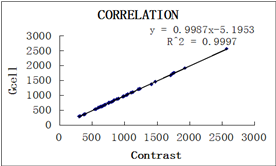Creatinine
Method:Sarcosine Oxidase Method Liquid reagent, R1: R2=3:1
CLINICAL SIGNIFICANCE
Creatinine is a break-down product of creatine phosphate in muscle, and is usually produced at a fairly constant rate by the body (depending on muscle mass).
High creatinine blood levels can mean serious kidney damage or disease is present. Other conditions that can cause high blood creatinine levels include blockage of the urinary tract (such as by kidney stone), heart failure, dehydration, excessive blood loss that causes shock, gout, or muscle conditions (such as rhabdomyolysis, gigantism, acromegaly, myasthenia gravis, muscular dystrophy, and polymyositis).
Urine creatinine is increased in hypothyrosis, wasting disease, dermatomyositis, tetanus or typhus, but decreased in amyotrophy or leukemia.
PRECISION
|
Intra assay precision |
||
|
N=20 |
level 1 |
level 2 |
|
Mean(IU/ml) |
129.6 |
379.6 |
|
SD |
1.0 |
3.3 |
|
CV(%) |
0.8 |
0.9 |
|
Inter assay precision Level 1 |
|||
|
N=5 |
Batch 1 |
Batch 2 |
Batch 3 |
|
Mean(IU/ml) |
129.8 |
131.6 |
130.4 |
|
|
130.6 |
||
|
(Xmax-Xmin)/ |
0.9 |
||
|
Inter assay precision Level 2 |
|||
|
N=5 |
Batch 1 |
Batch 2 |
Batch 3 |
|
Mean(IU/ml) |
375.7 |
378.3 |
375.6 |
|
|
376.6 |
||
|
(Xmax-Xmin)/ |
0.7 |
||
Sensitivity
For analysis sensitivity, the absorbance change rate (△A/min) should be 750±150ABS under the concentration of 355umol/L.
Correlation
The correlation of a well-known brand(X) and Gcell(Y) is y=0.9987 x -5.1953,R2= 0.9997

Interference
|
Analytes |
Concentration |
|
Intralipid |
1000mg/dl |
|
Vc |
50mmol/L |
|
DB |
40mg/dl, |
|
Creatine |
10mg/dl |
Linearity
Linearity is up to 12000 μmol/L
